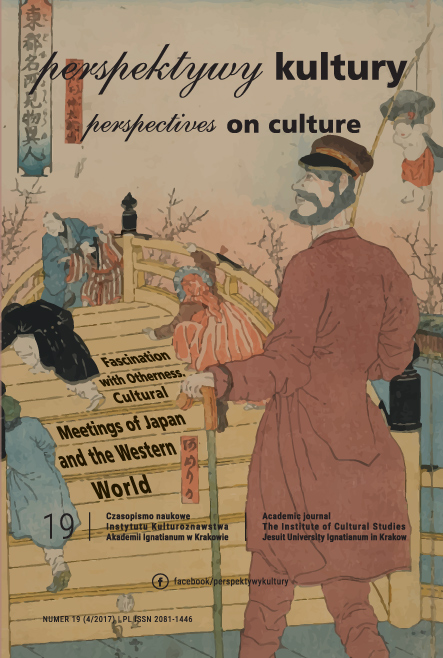The Art of Two Easts: the Great Sphinx on the Woodblock Prints of Hiroshi Yoshida
Abstract
Hiroshi Yoshida (1876-1950), a Japanese painter and woodcutter, was known for his excellent landscape compositions, creating paintings using the European oil technique. He traveled the world and also ex- perimented with traditional woodcut printing. His woodprints depict- ed non-Japanese landscapes and architectural objects, such as ones found in the United States, India, the Swiss Alps, etc. He cultivated the tradition of the ukiyo-e convention, restored in the twentieth century as shin-hanga. The article concerns one of these extraordinary works: the night and day views of the Great Egyptian Sphinx. The woodcut is very precise, and a few of its details allow us to determine the date of the creation of the prototype, as it depicts an important stage in the conservation works carried out on the famous statue. The article also digresses into interesting Japanese-Egyptian themes in the nineteenth century and the works of contemporary Japanese Egyptologists.
References
ALLEN Laura W. 2002. A Japanese Legacy: Four Generations of Yoshida Family Artists (Art Media Resources). Minneapolis: Minneapolis Institute of Arts.
BENNETT Terry. 1996. Early Japanese Images. Rutland: Charles Tuttle Comp.
BLAIR Dorothy. 1951. „Hiroshi Yoshida, 1876-1950”. Artibus Asiae, Vol. 14, No. 1/2, pp. 163-168.
BROWN Kendall H., GOODALL-CRISTANTE Hollis. 1996. Shin-Hanga: New Prints in Modern Japan, Los Angeles: County Museum of Art.
EASTON Matthew. 1992. „Scientists, Scholars and the Sphinx: A report from the Sphinx Conference”. American Research Center in Egypt Newsletter (Princeton) 156/157: 20-21.
LAL GAURI K., HOLDREN G.C. 1981. „Deterioration of the Stone of the Sphinx”. American Research Center in Egypt, Newsletter 114: 35-47.
LAL GAURI K. 1984. „Geological Study of the Sphinx”. American Research Center in Egypt, Newsletter 127: 19-27.
GNAEDINGER John P. 2006. Proposed Hypothesis, Testing and Documen- tation, and Actions to be Taken for the Conservation of the Sphinx, In The World of Ancient Egypt. Essays in Honor of Ahmed Abd el-Qadar el-Sawi, S. Abd el-Fatah, K. Daoud (eds.): 113-120. Cairo: Supreme Coun- cil of Antiquities.
HASSAN, Selim. 1949. The Sphinx. Its History in the Light of Recent Excava- tions, Cairo: Government Press.
HAWASS Zahi. 1992. History of the Sphinx Conservation, In Book of Pro- ceedings. The First International Symposium on the Great Sphinx: 165-214. Cairo: Egyptian Antiquities Organization Press.
HAWASS Zahi. 1998. The Secrets of the Sphinx. Restoration Past and Present. Cairo: The American University in Cairo Press.
KEYES Roger S. 1984. Japanese Woodblock Prints: A Catalogue of the Mary A. Ainsworth Collection. Oberlin, Ohio: Allen Memorial Art Museum, Oberlin College, Bloomington, Ind.
ROBINSON H.E., YASUNAGA Koichi. 1991. The Complete Woodblock Prints of Yoshida Hiroshi. North Clarendon VT: Tuttle Publishing.
MACLEAN Arthur J., BLAIR Dorothy. 1929. „Two Modern Japanese Print-Makers”. The American Magazine of Art, Vol. 20, No. 2 (February), pp. 98-101.
MERRITT Helen. 1990. Modern Japanese Woodblock Prints: The Early Years. Honolulu: University of Hawaii Press.
MERRITT Helen, YAMADA Nanako. 1995. Guide to Modern Japanese Wood- block Prints: 1900-1975, Honolulu: University of Hawaii Press.
MICHENER James A. 1959. Japanese Prints – From the Early Masters to the Modern. Tōkyō: Rutland.
NEWLAND Amy Reigle. 2005. Hotei Encyclopedia of Japanese Woodblock Prints. Amsterdam: Hotei.
OGURA Tadao. 1996. The Complete Woodblock Prints of Yoshida Hiroshi, Tōkyō: Abe Shuppan [Japanese text].
OSMAN Colin. 1990. „Antonio Beato: Photographs of the Nile”. History of Photography, vol. 14, no. 2 (April-June).
POLLARD Moyra Clare, LANDRUS Mallica Kumbera, LAHIRI Avijit. 2015. Yoshida Hiroshi: A Japanese Artist in India. Woodblock Prints from the Lahiri Collection. 9 June – 13 September 2015, the Ashmolean Museum of Art and Archaeology. Oxford: University Press.
SALTER Rebecca. 2002. Japanese Woodblock Printing. Honolulu: University of Hawaii Press.
SHARF Frederic A. 1994. Takejiro Hasegawa: Meiji Japan’s Preeminent Pub- lisher of Wood-Block-Illustrated Crepe-Paper Books. Salem: Peabody Essex Museum.
SKIBBE Eugene M. 1993. „The American Travels of Yoshida Hiroshi”. An- don 43 (January): 59-74.
SMITH Lawrence. 1994. Modern Japanese Prints 1912-1989. New York-Lon- don-Paris: Cross River Press.
STATLER Oliver. 1956. Modern Japanese Prints – An Art Reborn. Rutland: Tuttle Publishing.
STEWART Basil. 1979. A Guide to Japanese Prints and Their Subject Matter. New York: Dover Publications Inc.
VOLLMER April. 2012. „Mokuhanga International”. Art in Print, Vol. 2, No. 2 (July-August), pp. 4-13.
WAHBY Wafeek S. 2005. Restoring and Preserving Egypt’s Sphinx: the Poly- mers Option, 10th Canadian Masonry Symposium, Banff, Alberta, June 8-12, 2005 (online: http://www.canadamasonrydesigncentre.com/research/ restoring-and-preserving-egypts-sphinx-the-polymers-option/)
YOSHIDA Hiroshi. 1939. Japanese Woodblock Printing , comprehensive guide to the craft of woodblock printing written by Hiroshi Yoshida. Tōkyō-Osaka: Sanseido Company, Ltd.
YOSHIDA Hiroshi. 1987. The Complete Woodblock Prints of Yoshida Hiroshi. Tōkyō: Abe Publishing Co.
ZANNIER Italo. 1986. Verso oriente: Fotografie di Antonio e Felice Beato. Flo- rence: Alinari.
ZIVIE-COCHE Christiane. 1984. Sphinx, In Lexikon der Ägyptolo- gie, W. Helck, W. Westendorf (eds.), Vol. V: 1139-1147. Wiesbaden: Harrassowitz.
ZIVIE-COCHE Christiane. 2002. Sphinx: History of a Monument, Ithaca-London: Cornell University Press.
Copyright (c) 2017 Jesuit University Ignatianum in Krakow

This work is licensed under a Creative Commons Attribution-NoDerivatives 4.0 International License.
Autor, zgłaszając swój artykuł, wyraża zgodę na korzystanie przez Wydawnictwo Uniwersystet Ignatianum z utworu na następujących polach eksploatacji:
- utrwalania utworu w formie papierowej, a także na nośniku cyfrowym lub magnetycznym;
- zwielokrotnienia utworu dowolną techniką, bez ograniczenia ilości wydań i liczby egzemplarzy;
- rozpowszechniania utworu i jego zwielokrotnionych egzemplarzy na jakimkolwiek nośniku, w tym wprowadzenia do obrotu, sprzedaży, użyczenia, najmu;
- wprowadzenia utworu do pamięci komputera;
- rozpowszechniania utworu w sieciach informatycznych, w tym w sieci Internet;
- publicznego wykonania, wystawienia, wyświetlenia, odtworzenia oraz nadawania i reemitowania, a także publicznego udostępniania utworu w taki sposób, aby każdy mógł mieć do niego dostęp w miejscu i czasie przez siebie wybranym.
Wydawca zobowiązuje się szanować osobiste prawa autorskie do utworu.





